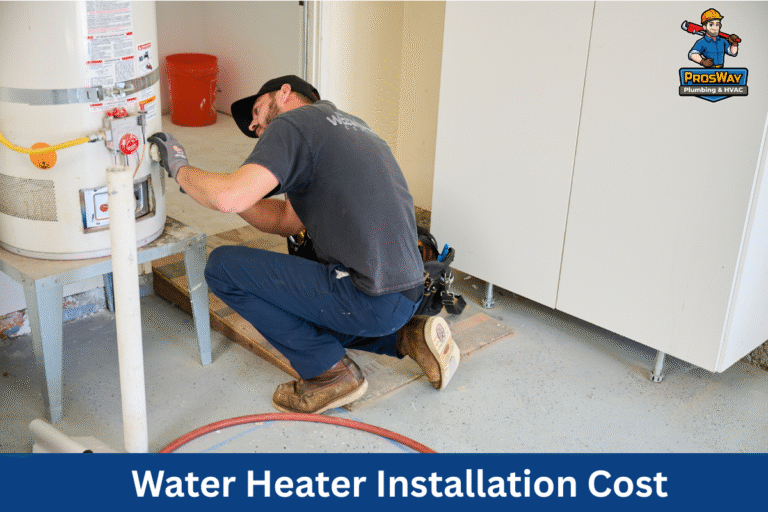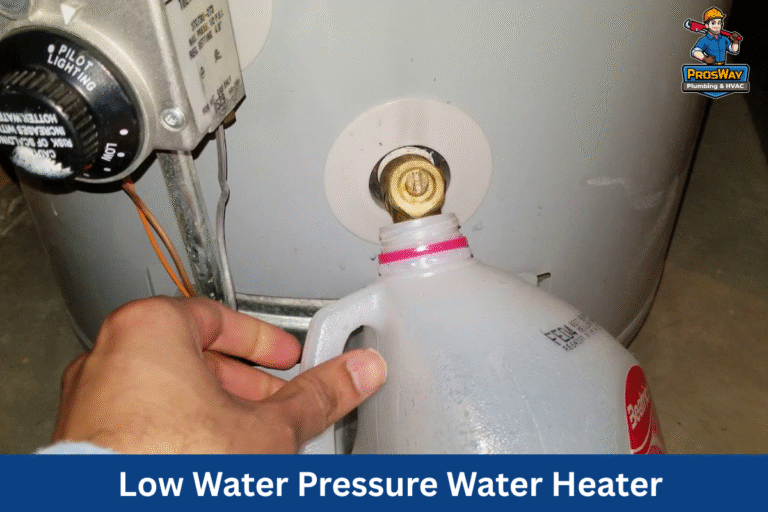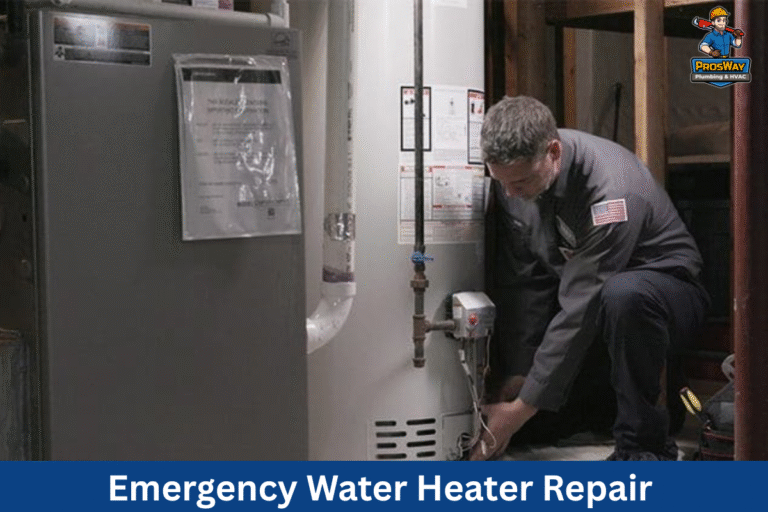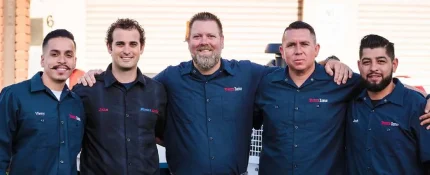Before scheduling sewer line maintenance, it’s essential to understand how your system works. At ProsWay Plumbing & HVAC, we know your main sewer line handles all waste from sinks, toilets, and drains, making it one of the most important parts of your home’s plumbing.
Our team uses sewer camera inspections to accurately map your sewer line, which often runs beneath basements or crawl spaces. This helps identify early signs of damage from tree roots, corrosion, or soil movement so we can prevent costly repairs before they happen.
What Materials and Components Should You Pay Attention To?
Identifying the key components of your sewer system is also essential. Typically, a sewer system consists of segments of cast iron, PVC, or even newer trenchless sewer lines installed using modern methods.
The material used plays a significant role in maintenance; while cast iron pipes are durable, they are prone to corrosion and leaks as they age, whereas PVC pipes may be more flexible but can suffer from root intrusion.
The connections include joints and valves that control flow, and regular maintenance can detect if these parts leak or get blocked.
Common materials used in sewer line construction include cast iron, which offers strength but can rust, and PVC, which is lightweight and resistant to many chemicals but can become brittle under prolonged exposure to extreme temperatures.
Each of these materials behaves differently under stress, such as from a frozen winter in Northern New Jersey or high heat conditions in the summer.
Typical lifespans of different sewer line types vary widely. For example, cast iron pipes can last 50 years or more with proper care, but if they are subjected to constant wear or improper installation, their lifespan can be shortened dramatically.
Modern trenchless sewer repair techniques have extended the useful life of many sewer systems by reducing the need for disruptive excavation. As such, the age and construction of your sewer line help in planning your maintenance schedule effectively.
How Can You Maintain Your Sewer Line Proactively?

Proactive sewer line maintenance involves regular checks and care practices that ensure the longevity of your sewer system. The main goal of these best practices is to prevent emergencies, such as backups and leaks, which can lead to flooding and significant damage to your basement, lawn, or foundation.
Why Is Proper Drain Usage Important for Sewer Health?
Adopting safe flushing and draining habits is essential to avoid clogging and damage. Many homeowners do not realize that putting items like garbage, grease, or even dental floss down the drain can accumulate and cause a blockage over time.
Instead, ensure that food waste is properly disposed of, and use strainers in sinks to catch any debris. Avoid using chemical drain cleaners that can compromise the integrity of your pipes.
Another best practice is managing tree root intrusion near sewer lines. Tree roots are naturally attracted to the moisture in sewer pipes and can grow into cracks or joints over time.
Once roots penetrate a pipe, they can exacerbate cracks and cause internal blockages. Schedule regular inspections and consider using trenchless technology like pipe bursting or sliplining to repair damaged sections caused by root intrusion.
How Do Inspections and Water Use Affect Sewer Longevity?
Scheduling regular professional sewer line inspections is a vital component of maintenance. Professionals use sewer cameras and advanced diagnostic tools to detect early signs of wear and tear or blockages.
These inspections can reveal corrosion, cracks, or even small leaks before they worsen. Investing in periodic maintenance, albeit at a cost, saves money in the long term by preventing emergencies.
Many experts recommend an annual inspection, particularly for older systems or those in areas with extreme weather conditions like Northern New Jersey, where the ground freezes and thaws.
Implementing water conservation to reduce strain on your sewer system is a proactive measure that also benefits your overall water bill.
When you reduce the amount of water going through your sewer line, you decrease the pressure for leaks or bursts.
Simple practices such as repairing dripping faucets or installing low-flow fixtures can lower the volume of wastewater being discharged. This conservation practice supports environmental sustainability.
Keeping accurate records of all maintenance works, professional inspections, and repairs will help you track trends and detect recurring issues early. These records can be essential when planning future repairs.
What Are Essential Sewer Line Maintenance Techniques for Homeowners?
Performing routine visual checks for leaks or damage forms the cornerstone of effective sewer line maintenance. Homeowners should periodically inspect areas where sewer lines are accessible, such as crawl spaces or outdoor clean-outs.
Look for signs like damp patches on walls or floors, unusual stains, or corrosion around pipe joints. Early detection of such symptoms can prevent further deterioration that might lead to costly repairs. Regular checks also involve monitoring the sound of your pipes.
Why Should You Use Biological Cleaners for Routine Maintenance?
Using biological cleaners for pipe health is an environmentally friendly alternative to harsh chemical drain cleaners. Biological cleaners use enzymes and naturally occurring bacteria to break down organic material within the pipes.
These biological solutions help maintain a balanced microbial environment that can naturally prevent buildup.
By choosing biological cleaners, homeowners also avoid the risk of chemical corrosion, which can compromise older pipes like those made of cast iron.
A manual or electric drain snake can help dislodge stubborn blockages that biological cleaners cannot reach. For instance, clogs caused by significant accumulation of food waste or by tree roots require mechanical methods.
If you notice slow drains in multiple parts of your home, it might indicate that the blockage is progressing beyond a simple clog.
While many utility companies recommend avoiding excessive use of chemical drain cleaners, mechanical augers provide a physical solution that can clear out obstructions effectively.
Risks of Relying on Chemical Drain Cleaners
Recognizing the limitations of chemical drain cleaners is another important technique. They often contain corrosive substances that can erode the interior of your pipes over time. In addition, these chemicals are not effective for long-term maintenance.
The recurring use of harsh chemicals can lead to root damage in your pipes, potentially speeding up the need for full-scale pipe repair or replacement. Homeowners should consider more sustainable alternatives, including mechanical cleaning or biological methods, as previously discussed.
Keeping accurate records of maintenance and inspections is a technique frequently overlooked but immensely valuable. Document every cleaning, inspection, repair, and even minor issues detected by professionals.
To help illustrate maintenance techniques, consider the following list of steps:
- Visual Inspection – Check accessible areas for signs of leaks, stains, or corrosion.
- Biological Cleaning – Use enzyme-based cleaners to prevent organic buildup.
- Mechanical Intervention – Deploy a drain snake or auger when blockages persist.
- Chemical Avoidance – Limit the use of harsh cleaners that can corrode pipes.
- Record Keeping – Maintain comprehensive logs of all maintenance actions.
How to Detect Early Indicators of Sewer Line Distress?

Signs of sewer line distress are essential for homeowners who wish to prevent major plumbing disasters. Noticing slow drains throughout your property is usually the first indicator of a possible sewer line problem.
When more than one drain begins to flow slowly, it is a red flag that your main sewer line might be experiencing a blockage.
Such slow drains are often caused by a buildup of grease, food waste, or even tree roots entering the pipe.
Acting quickly can prevent a full backup, which in the worst cases can flood your basement or damage your foundation.
What Noises and Odors Should Homeowners Watch For?
Investigating unusual gurgling sounds from pipes can also alert you to underlying issues. These sounds typically occur when there is an obstruction in the line that prevents normal wastewater flow, resulting in air being pulled through the pipe, which creates gurgling noises.
The sound may be faint at first, but it can become more prominent as the blockage worsens. A continuous gurgle is a sign that professional intervention may be needed before the condition escalates into a more severe leak.
Addressing persistent foul odors indoors or outdoors is another key indicator. Sewer gas, which can include methane and hydrogen sulfide, is hazardous to health. Immediate action is required in cases of persistent sewer odors.
Why Do Yard Changes and Pest Issues Signal Trouble?
When your sewer pipe is cracked or damaged, wastewater can leak into the surrounding soil, causing localized drainage issues. These patches might appear as soft, muddy spots on your lawn and should be investigated promptly.
In many instances, these ground-level symptoms are the first visible signs that something is amiss with the underground system. Monitoring for pest infestations around drains is equally important. Rodents and insects are typically attracted to clogged pipes and damaged sewer lines.
To help you remember these symptoms more clearly, here is a detailed list of indicators:
- Slow Drains – Simultaneously occurring slow drainage across multiple fixtures.
- Gurgling Sounds – Unusual noises that signify airway obstruction and blockages.
- Foul Odors – Persistent smells of sewer gas that indicate gas leakage.
- Soggy Yard Areas – Soft or wet patches indicate a potential leak.
- Pest Infestations – An increase in rodents or insects around drain areas.
Each of these early warning signs demands a careful and prompt investigation. Regularly monitoring them can allow homeowners to catch issues before they evolve into emergencies that require extensive pipe replacement or repair.
A proactive approach to detecting these issues may include scheduling periodic sewer scope inspections through trusted local services in Northern New Jersey, ensuring that any signs of distress are addressed promptly.
Which Sewer Repair Techniques Work Best?
When sewer line distress is detected, applying the correct repair method is crucial. Traditional excavation repair for severe damage involves digging up the affected area to access the old, damaged pipe.
This method is thorough and allows for the replacement of the entire section of the impacted pipe.
Although it can be disruptive, resulting in signs of disturbance on the lawn or basement, it is often necessary when there is extensive decay.
Modern trenchless pipe lining solutions offer a less invasive alternative. In these repair methods, a resin-saturated liner is inserted into the damaged pipe and then cured in place, forming a hard new pipe within the old one.
Watch this video for more insights: The Trenchless Pipelining Process Explained.
This method significantly reduces the time and labor involved because there is no need to dig up long stretches of the property. Trenchless technology minimizes disruption to lawns and driveways while effectively repairing leak-prone sections.
Utilizing pipe bursting for replacement is another advanced method. In this process, a bursting head is forced through the old pipe, breaking it apart as a new pipe is simultaneously laid into place.
Pipe bursting is an efficient method of replacement that avoids the mess and inconvenience of a full excavation. This method is particularly suitable for tracking down root intrusion and severe corrosion that cannot be fixed alone.
How Do You Choose the Right Sewer Line Repair Option?
Selecting the appropriate repair method for your situation depends on several factors. These include the extent and location of damage, the pipe material, available budget, and the degree of disruption acceptable to the homeowner.
Homeowners should also consider the age of the existing pipe and any history of repairs or maintenance.
In Northern New Jersey, where ground conditions can vary greatly, the choice of repair strategy might be influenced by local soil conditions and weather patterns that affect ground stability.
Before selecting a repair method, it is advisable to consult with experienced sewer specialists, such as those provided by ProsWay Plumbing & HVAC. They can offer a detailed assessment and recommend a strategy that balances effectiveness, cost, and disruption.
In many cases, a combination of treatments may be used; for example, spot repairs might be performed quickly to handle urgent issues while planning a future trenchless sewer repair for a more permanent solution.
The following table summarizes various sewer line repair methods, their advantages, and potential drawbacks:
| Repair Method | Advantages | Drawbacks | Best For |
|---|---|---|---|
| Traditional Excavation | Permanent solution, thorough replacement | Disruptive; higher cost | Extensive damage, old cast iron pipes |
| Trenchless Pipe Lining | Minimal disruption, faster repair time | Limited by pipe diameter and damage scope | Moderate wear, localized corrosion |
| Pipe Bursting | Efficient replacement, less excavation | Requires specialized equipment | Severe root intrusion, total pipe failure |
| Spot Repairs | Cost-effective, less invasive | Temporary; may not address root cause | Minor cracks and localized leaks |
| Epoxy Lining/Repair | Quick application, prevents further corrosion | Not suitable for extensive damage | Small breaks and early stages of decay |
When Should You Call a Sewer Line Specialist?

Partnering with professionals is paramount to achieving optimal sewer line care. Choosing qualified and licensed sewer line specialists ensures that you receive accurate diagnostics and effective repairs.
Professionals are equipped with advanced tools such as sewer cameras and ultrasonic testing devices, which help pinpoint wear and tear, thereby guiding effective repair measures.
What Happens During a Professional Sewer Inspection?
What to expect during a professional sewer inspection is straightforward. The process typically starts with a visual survey and a camera inspection of the sewer line from key access points, such as cleanouts.
The specialist will then evaluate the condition of the pipe lining, any potential blockages, and overall structural integrity. Often, a mini report is provided detailing the findings along with photographic evidence of major issues.
Professional service providers will offer you an upfront estimate that outlines the cost and expected timeline of the repair work. Transparent communication about service charges and follow-up maintenance is key to ensuring that there are no surprises down the line.
Video Inspections and Post-Repair Care
The role of video camera inspections in diagnosis cannot be overstressed. With this technology, experts are able to visually inspect even the most inaccessible recesses of your sewer line.
Video camera inspections provide a real-time view of the internal pipeline condition, highlighting issues such as cracks, corrosion, or blockages caused by tree roots or debris.
This method has become the standard in modern sewer line maintenance.
Post-repair care and future prevention strategies are also part of professional services. Once repairs are completed, professionals often provide guidelines on how to care for your newly fixed sewer line.
This advice might include recommendations on what not to flush, how to avoid chemical drain cleaners, and the ideal schedule for further inspections. Regular follow-up appointments are sometimes offered at reduced rates.
Working with professionals provides you with long-term solutions tailored to your property. Their expertise in sewer line cleaning, repair, and maintenance is backed by years of local experience in Northern New Jersey.
Frequently Asked Questions
What are the early signs of a failing sewer line?
Early signs include slow drains, gurgling noises from pipes, foul odors indicating sewer gas, and soggy patches on the lawn. These symptoms point to blockages, leaks, or damage in the sewer system that need professional inspection. It is advisable to address them promptly to prevent larger issues.
How often should I have my sewer line inspected?
Most experts recommend a professional sewer line inspection once a year, especially for older systems. Regular inspections using techniques like sewer scope inspection can detect early signs of wear, corrosion, or blockages, thereby minimizing unexpected repair costs.
What repair methods are available for a clogged sewer line?
There are several repair methods, including traditional excavation, trenchless pipe lining, pipe bursting, spot repairs, and epoxy lining. The choice of method depends on the severity of the damage, pipe material, and cost considerations. Professionals can help decide the most effective solution for your specific scenario.
Why should I hire a professional for sewer line maintenance?
Professional support ensures accurate diagnosis, efficient repairs, and proper documentation of the work. Experts have the tools and experience to handle complicated issues, reducing the risk of recurrence.
Moreover, professionals offer warranties and follow-up services to maintain home safety over time. You should consider hiring a professional for your sewer line repairs.
Final Thoughts
Maintaining your sewer line is essential for protecting your home from costly repairs, floods, and health hazards such as sewer gas. Your home’s sewer system and adopting proactive maintenance practices can prevent major issues before they arise. With effective repair methods and timely professional interventions, you can extend the life of your sewer line and ensure a safe, efficient plumbing system.
Keep Your Sewer Line Flowing Smoothly With ProsWay!
Don’t wait for a backup to disrupt your home. Schedule a professional sewer line inspection with ProsWay Plumbing & HVAC today and ensure your system stays in top shape. Call us now at (862) 260-5870 or Book Online for a detailed inspection, honest estimate, and expert solutions that protect your property.









